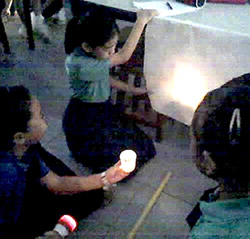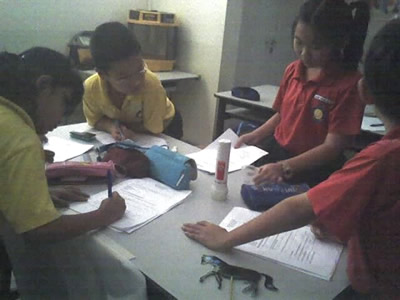Why Singapore’s English Teachers Should Embrace Singlish, Not Fight It
Is it time for Singaporean educators to embrace Singlish as a legitimate learning tool? What the Research […]
Read More
Seng Kang Primary teachers show us how structured play can be more than fun and games.
 How did Benjamin Franklin discover that lightning was electricity? Or Thomas Edison invent the light bulb? Whether you cite intuition, intelligence or just sheer luck, one thing’s for sure: they didn’t get the answers from their Science teacher.
How did Benjamin Franklin discover that lightning was electricity? Or Thomas Edison invent the light bulb? Whether you cite intuition, intelligence or just sheer luck, one thing’s for sure: they didn’t get the answers from their Science teacher.
This is why Primary 4 teachers from Seng Kang Primary School were understandably worried when that seemed to be the only thing their students seemed to do.
“Whenever we posed questions they always come back empty-handed,” recalls Mdm Siswati Ahmad. “They were always waiting for the answers to be given to them.”
While the “teacher teaches and I listen” attitude can be found in Maths and English classes too, it seemed especially disturbing in a subject that is supposed to be about experimentation and discovery. “That’s just not the way to do Science,” Siswati says firmly, shaking her head. “You can’t just learn it by reading a book or listening to the teacher. You have to explore and discover things on your own.”
To deal with this problem, teachers knew they needed a strategy which could get the children motivated and ensure that they learned the lesson as well. In the end, the solution was inspired by the students themselves. “We realised that children love to play so we thought that if it was structured properly, perhaps it would help them learn the concepts better,” explains Siswati.
 In 2006, the teachers put their theory to the test by embarking on an action research project called “Lights Up!” where they aimed to encourage independent learning by designing activities which allowed students to learn the properties of light through structured play.
In 2006, the teachers put their theory to the test by embarking on an action research project called “Lights Up!” where they aimed to encourage independent learning by designing activities which allowed students to learn the properties of light through structured play.
What followed was a 5-week period of, well…fun and games! Although teachers still presented lectures in class, these were limited to brief PowerPoint presentations on the concepts of light. Most of the time, students worked in small groups to figure out answers on their own.
Even the lesson’s “closure” was all about group interaction. “Most of the time, a majority of the groups get the correct concepts,” says Siswati. “We invite the groups to share their results then ask the others to improve on what has been presented. It’s really about questioning and getting them to improve their own answers.”
But how did this go down with students who lacked the initiative in the first place?
“At first, the students were shocked. They were like, ‘What are we doing?!’” Siswati laughs. “It was only later on when they stopped asking us how things were done or what this meant. They started to realise that, ‘I can read this first then try it out on my own.’”
Of course, like any action research initiative, the “Lights Up!” project had its own share of challenges. For the P4 teachers, the time-consuming nature of hands-on activities became a problem when it came to finishing the required content.
To address this issue, teachers converted Science remediation to Science supplementary lessons so they could have students come back to class for an extra hour. Luckily, their new teaching approach was an undeniable hit. “The kids loved it,” beams Siswata. “They don’t mind because they know Science supplementary means ‘playtime’ and they’re not just going to be sitting down for remediation.”
Yet, the lack of time translates to issues of sustainability as well. Siswati admits that it would be difficult to apply such self-directed activities to all topics in class. Maintaining the positive effects of the project is also not assured when students move on to the next level. “AR was successful for this activity but the sustainability of the students’ motivation is yet to be seen,” she says. “Now they’re in another level, learning other Science topics. It’s up to this new group of teachers if they want to take on this project.”
Another issue was the reliability of the research design itself. As the school enters its fifth year of doing AR, it faces the same criticism that has plagued other forms of teacher-led research.
Jasmine Chan, the school’s AR coordinator is well aware of such challenges. “When we write our reflections, the research outcomes are always positive. It’s always a success and students always get better. But we use very conventional methods like the pretests, interventions, and post tests. We also don’t have control groups so there’s no comparison,” she says.
Of course, the idea of making research more “rigorous” can definitely raise a few eyebrows among the faculty. Vice-Principal Angie Ong is frank about the limitations of research at the school: “Quantitative methodology is something that may put people off because not everybody can take to numbers. We kept things simple and chose an approach that worked for us.”
“Teachers used these strategies in class because they wanted to improve their students’ abilities,” adds Jasmine, “That was their main concern and not so the technical aspects of research. I think this year we might look into learning more research design to ensure that our research is really valid and reliable.”
>While the approach of such action research studies continues to be a debatable issue, Siswati is content with the fact that the “Lights Up!” project helped her students experience the true nature of learning Science. “I guess our major concern was that the children improve from where they are. When we see an improvement, we consider it a success.”
And yes, there has definitely been some improvement. Interviews and surveys show that students enjoyed the exploratory activities and wished there would be more hands-on work in the future. “For once, they got to do something without the teacher telling them what to do!” Siswati exclaims. A post-test also shows that more than half of the students understood the concepts that the teachers wanted them to learn.
Yet, perhaps one of the most unexpected results was how the approach was well received, even among students who don’t usually do well in school. “Actually, the weakest class enjoyed it more than the better class,” says Siswati. “They really understood the topic more while the top-end classes did more or less the same in terms of scores.” “The better students actually felt very insecure that there were no notes,” Jasmine chuckles.
Although the P4 teachers have concluded their action research project, “Lights Up!” is still used to teach the current batch of Primary 4 students. The AR results have also been shared with other teachers in the school. “That is our ultimate aim. When we do our sharing, we hope that other levels will actually take on these approaches,” says Jasmine.
Through all of this, the school administration remains determined to keep teachers inspired to try things out. “In any innovation or approach, teachers must feel a kind of confidence that they can do it and if mistakes are made, it’s fine,” says Angie. “With that liberty and ease of mind, teachers have taken flight to do things on their own.”
Yet Siswati sums it up best with her own take on what AR is about: “When we do research, the problem concerned is closer to our hearts. These are things we face every day. That’s why I think it’s a good venue.”